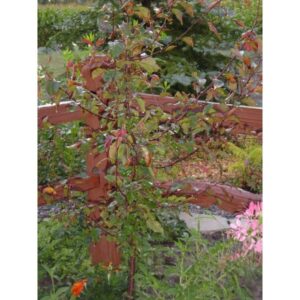Showing the single result
Wholesale Plum Trees in Michigan
Cold Stream Farm produces wholesale plum trees grown in our headquarters in Free Soil, Michigan. We currently have no minimum order requirements on retail and wholesale plum tree shipments with trees for sale in a few different life stages.
Our wholesale plum trees are typically only available in the spring. In the United States, there are restrictions on shipping plum trees to California, Washington, Oregon, and Idaho with additional limitations on Canadian orders. Please contact Cold Stream Farm today with any questions about your next order.
About American Plum (Prunus americana)
We supply American Plum (Prunus americana), which is a plum plant native to much of the American east and midwest. Prunus americana grows naturally from Idaho to Massachusetts, as far south as Florida and up into Maine and Quebec.
The species is commonly confused with the Prunus Nigra (the Canadian plum), which can be distinguished after identifying its yellow fruit. Other common names for Prunus americana include large yellow sweet plum, wild plum, wild yellow plum, and red plum.
Size and Appearance
American plum plants toe the line between classification as a small tree or a large bush. The plants reach a mature height of about 20 feet, featuring a broad crown of thorny branches. Plum trees are very shallow rooted, with extensive growths suckering and widely spreading.
The leaves of an American plum tree are dark green with a lighter underside. In the spring small, white five-petal flowers bloom in small clusters. The fruit, or the “plum” itself, is merely one inch in diameter when fully grown.
Culinary Uses for American Plums
The small edible fruit of an American Plum (Prunus americana) plant has a variety of culinary uses. As a sour and sweet naturally growing fruit, the plums can be eaten directly off of the plant or made into another form.
Most commonly, Prunus americana fruit is used in wine, jellies, and jams. American plums have been eaten by humans for centuries, with the earliest records dating back to the Cheyenne and Plains Indians.
Ecology and Wildlife Interaction
Besides the human race, the American plum plant is eaten by many other mammals and species of wildlife. The fruit is consumed primarily by birds such as grouse, pheasant, and quail and is also eaten alongside the twigs and leaves by white-tail and mule deer.
Uses for Planting American Plum Shrubs
As a spreading plant that resembles a large, flowering weed, the American plum is used both ornamentally and practically throughout North America. The root system is great for stabilizing banks of rivers and improving gullies. Growing in dense thickets, plum shrubs help break the wind near roads and rivers.
Other Human Uses for Plum Trees
Aside from looking good, improving soil conditions, breaking wind, and bearing edible fruit, many plum tree parts have been utilized by people for centuries. Native Americans used Puruns Americana roots to create red dye for weaving into clothes, blankets, and rugs. Ceremonially, the branches of a plum tree were also used during Plains Indians’ Sun Dance festival.
Best Conditions for Growing Prunus Americana Growing
American plum trees are best grown in full sun, within USDA Hardiness zones 3 to 8. The plant is resistant to cold weather conditions but may struggle against extensive drought, shade, and fire. It is very flood-tolerant, making it ideal next to sources of water or in lower swampy areas of a commercial or residential property.
Prunus Americana is tolerant of poor soil conditions and able to withstand poorly-drained properties. Moist conditions are ideal and the plant is also great for sandy soil areas.
How to Plant and Maintain American Plum Shrubs
If you are planning to add American plum shrubs as a windbreak, they are ideally planted with about eight feet between each trunk. The plants will spread quickly, filling out the space and growing upwards while improving the soil beneath.
In terms of maintenance, there is not much that needs to be done if the plant is located adjacent to a source of water. Ensuring the soil remains moist, the only other thing that growers must consider is pruning and shaping if necessary.
Common Issues to Look Out For
Although they are “born to be wild,” American plum trees may be subject to diseases from pests like aphids, caterpillars, and borers. Light fertilization may be necessary and egg-laying moths can also be stopped with sticky traps. While plum shrubs generally grow well without any maintenance at all, fungal sprays applied early in a plant’s life are best utilized in the spring.
Wholesale plum trees in Michigan from Cold Stream Farm.
Ready to get started on your next order? Contact us or purchase your plants online today. Cold Stream Farm has a limited supply of plum trees, with wholesale and retail shipments at no minimum order available throughout the United States. Please check our current stock of plum trees before placing your order and note that plants between one and four feet may only be available in the spring.


